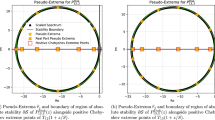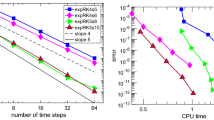Abstract
Two new Runge–Kutta (RK) pairs of orders 6(4) and 7(5) are presented for solving numerically the inhomogeneous linear initial value problems with constant coefficients. These new pairs use only six and eight stages per step respectively. Six stages are needed for conventional Runge–Kutta pairs of orders 5(4) while for such a pair of orders 6(5) we use eight stages. Thus, our proposal is an improvement and it is achieved since the set of order conditions is smaller in the case of interest here. Since traditional simplifications for derivation of Runge–Kutta methods do not apply for this reduced set, we proceed using the differential evolution technique for solving it. We finalize by performing tests over some relevant problems with very pleasant results.




Similar content being viewed by others
References
Butcher, J.C.: Implicit Runge-Kutta processes. Math. Comput. 18, 50–64 (1964)
Butcher, J.C.: On Runge-Kutta processes of high order. J. Austral. Math. Soc. 4, 179–194 (1964)
Butcher, J.C.: The Numerical Analysis of ODEs: Runge-Kutta and General Linear Methods. Wiley, Chichester (1987)
Dormand, J.R., Lockyer, M.A., McGorrigan, N.E., Prince, P.J.: Global error estimation with Runge-Kutta triples. Comput. Maths. Appl. 18, 835–846 (1989)
Dormand, J.R., Prince, P.J.: A family of embedded Runge-Kutta formulae. J. Comput. Appl. Math. 6, 19–26 (1980)
England, R.: Error estimates for Runge? Kutta type solutions of systems of ordinary differential equations. Comput. J 12, 166–170 (1969)
Enright, W.H.: The efficient solution of linear constant-coefficient systems of differential equations. Simulation 30, 129–133 (1978)
Famelis, I.T., Papakostas, S.N., Tsitouras, Ch.: Symbolic derivation of Runge-Kutta order conditions. J. Symbolic Comput. 37, 311–327 (2004)
Fehlberg, E.: Low order classical Runge-Kutta formulas with step-size control and their application to some heat transfer problems, NASA Tech. Rep. TR R-315, 1969, G. C. Marsal Space Flight Center, Ala. 35812
Hairer, E., Nørsett, S.P., Wanner, G.: Solving Ordinary Differential Equations I. Springer, Berlin (1987)
Hochbruck, M., Ostermann, A.: Explicit exponential Runge–Kutta methods for semilinear parabolic problems. SIAM J. Numer. Anal. 43, 1069–1090 (2005)
Hui, F., Simos, T.E.: Four stages symmetric two-step p-stable method with vanished phase-lag and its first, Second, Third and Fourth derivatives. Appl. Comput. Math. 15, 220–238 (2016)
Jansing, G.: EXPODE - Advanced Exponential Time Integration Toolbox For MATLAB, Code Documentation. arXiv:1404.4580v1 [math.NA] (2014)
Katsikis, V.N., Papakostas, S.N., Tsitmidelis, S., Tsitouras, Ch.: Evolutionary Generation of Explicit Two Step Methods for Second Order Linear IVPs, AIP Conf. Proc., 1738, No 480038 (2016)
Kovalnogov, V.N., Simos, T.E., Tsitouras, Ch.: Ninth Order, Explicit, Two Step Methods for Second Order Inhomogeneous Linear IVPs, Math. Meth. Appl. Sci., to appear
Lambert, J.D.: Numerical Methods for ODEs. Wiley, Chichester (1991)
Lin, C., Chen, J.J., Simos, T.E., Tsitouras, Ch.: Evolutionary derivation of sixth order P–stable SDIRKN methods for the solution of PDEs with the Method of Lines, Mediter. J. Maths, 16, Article ID: 69 (2019)
Lin, Chialiang, Hsu, Chieh-Wen, Simos, T.E., Tsitouras, Ch.: Explicit, semi-symmetric, hybrid, six-step, eighth order methods for solving y\(^{\prime \prime }=\)f(x,y). Appl. Comput. Math. 18, 396–304 (2019)
Liu, C., Hsu, C.-W., Tsitouras, Ch., Simos, T.E.: Hybrid Numerov–type methods with coefficients trained to perform better on classical orbits. B. Malays. Math. Sci. So 42, 2119–2134 (2019)
Low, K.H.: Displacement and Frequency analyses of vibratory systems. Comput. Struct. 54, 743–755 (1995)
MATLAB version R2019b, The Mathworks, Inc., Natick, MA
Medvedev, M.A., Simos, T.E., Tsitouras, Ch.: Fitted modifications of Runge-Kutta pairs of orders 6(5). Math. Meth. Appl. Sci. 41, 6184–6194 (2018)
Medvedev, M.A., Simos, T.E., Tsitouras, C. h.: Trigonometric-fitted hybrid four-step methods of sixth order for solving \(y^{\prime \prime }(x)=f(x,y)\). Math. Meth. Appl. Sci. 42, 710–716 (2019)
Papageorgiou, G., Famelis, I.T., Tsitouras, Ch.: A P-stable singly diagonally implicit runge-kutta-nyström method. Numer. Algorithms 17, 345–353 (1998)
Papageorgiou, G., Tsitouras, C. h., Famelis, I.T.: Explicit Numerov type methods for second order IVPs with oscillating solutions. Int. J. Modern Phys C 12, 657–666 (2001)
Papageorgiou, G., Tsitouras, Ch., Papakostas, S.N.: Runge-kutta pairs for periodic initial value problems. Computing 51, 151–163 (1993)
Papakostas, S.N., Tsitouras, Ch., Papageorgiou, G.: A general family of explicit Runge-Kutta pairs of orders 6(5). SIAM J. Numer. Anal. 33, 917–936 (1996)
Shampine, L.F.: Cheaper integration of linear systems. Simulation 20, 17 (1973)
Shampine, L.F.: Some practical Runge–Kutta formulas. Math. Comput. 46, 135–150 (1986)
Simos, T.E.: Multistage symmetric two-step P-stable method with vanished phase-lag and its first, second and third derivatives. Appl. Comput. Math. 14, 296–315 (2015)
Simos, T.E., Tsitouras, Ch.: Evolutionary generation of high order, explicit, two step methods for second order linear IVPs. Math. Meth. Appl. Sci. 40, 6276–6284 (2017)
Simos, T.E., Tsitouras, Ch.: High phase–lag order, four–step methods for solving \(y^{\prime \prime }=f(x,y)\). Appl. Comput. Math. 17, 307–316 (2018)
Simos, T.E., Tsitouras, Ch.: Explicit, Ninth order, two step methods for solving inhomogeneous linear problems \(x^{\prime \prime }(t)={\Lambda } x(t)+f(t)\). Appl. Numer. Math. 153, 344–351 (2020)
Simos, T.E., Tsitouras, Ch., Famelis, I.Th.: Explicit numerov type methods with constant coefficients: a review. Appl. Comput. Math. 16, 89–113 (2017)
Storn, R., Price, K.: Differential evolution – a simple and efficient heuristic for global optimization over continuous spaces. J. Glob. Optim. 11, 341–359 (1997)
Tsitouras, C. h.: A tenth order symplectic Runge-Kutta-Nyström method. Cele. Mech. Dynamical Astron. 74, 223–230 (1999)
Tsitouras, Ch.: Explicit two–step methods for second order linear IVPs. Comput. Math. Appl. 43, 943–949 (2002)
Tsitouras, Ch.: Explicit Runge–Kutta methods for starting integration of Lane–Emden problem. Appl. Math. Comput. 354, 353–364 (2019)
Tsitouras, Ch., Papakostas, S.N.: Cheap error estimation for Runge-Kutta methods. SIAM J. Sci. Comput. 20, 2067–2088 (1999)
Tsitouras, Ch., Simos, T.E.: High algebraic, high phase-lag order embedded Numerov-type methods for oscillatory problems. Appl. Math. Comput. 131, 201–211 (2002)
Tsitouras, Ch., Simos, T.E.: Trigonometric fitted explicit Numerov type method with vanishing phase–lag and its first and second derivatives, Mediterr. J. Math., 15(168) (2018)
Van Der Houwen, P.J., Sommeijer, B.P.: Explicit runge-kutta-nyström methods with reduced phase errors for computing oscillating solutions. SIAM J. Numer. Anal. 24, 595–617 (1987)
Zingg, D.W., Chisholm, T.T.: Runge-kutta methods for linear ordinary differential equations. Appl. Numer. Math. 31, 227–238 (1999)
Author information
Authors and Affiliations
Corresponding author
Additional information
Publisher’s note
Springer Nature remains neutral with regard to jurisdictional claims in published maps and institutional affiliations.
Highly Cited Researcher (2001-2013 List, 2017 List and 2018 List), Active Member of the European Academy of Sciences and Arts. Active Member of the European Academy of Sciences. Corresponding Member of European Academy of Arts, Sciences and Humanities.
Rights and permissions
About this article
Cite this article
Simos, T.E., Tsitouras, C. Evolutionary derivation of Runge–Kutta pairs for addressing inhomogeneous linear problems. Numer Algor 87, 511–525 (2021). https://doi.org/10.1007/s11075-020-00976-9
Received:
Accepted:
Published:
Issue Date:
DOI: https://doi.org/10.1007/s11075-020-00976-9




